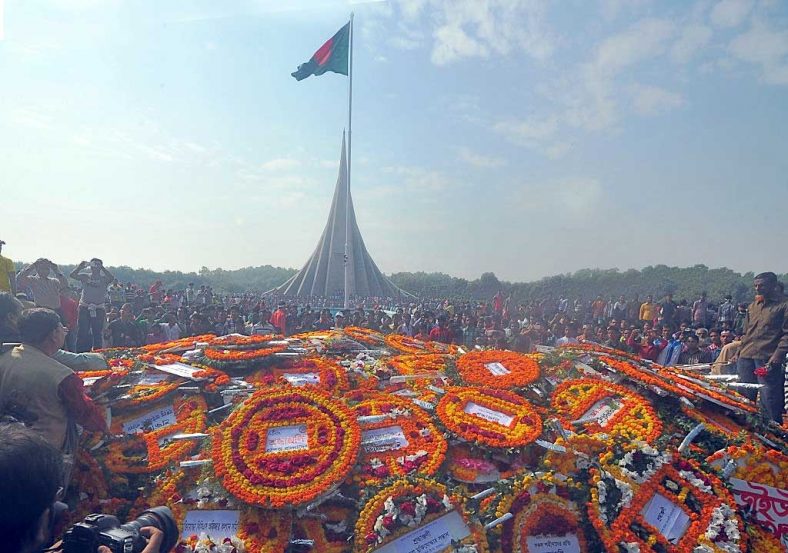

The day's highlight is the national holiday parade on Dhaka's National Parade Ground, hosted by the Bangladesh Armed Forces and involves personnel from the Bangladesh Police, Border Guard Bangladesh, Bangladesh Jail and Bangladesh Ansar. Different political parties and socioeconomic organisations undertake programs to mark the day in a befitting manner, including the paying of respects at Jatiyo Smriti Soudho, the national memorial at Savar in Dhaka District. The main streets are decorated with national flags.
VICTORY DAY OF BANGLADESH TV
TV and radio stations broadcast special programs and patriotic songs. Victory Day in Bangladesh is a joyous celebration in which popular culture plays a great role. The ritual of the celebration gradually obtained a distinctive character with a number of similar elements: Military Parade by the Bangladesh Armed Forces at the National Parade Ground, ceremonial meetings, speeches, lectures, receptions and fireworks displays. The Bangladesh Liberation War became a topic of great importance in cinema, literature, history lessons at school, the mass media, and the arts in Bangladesh. The celebration of Victory Day has been taking place since 1972. Jatiyo Smriti Soudho at Savar, a tribute to the martyrs of the Bangladesh Liberation War Celebration In 1996, the Bangladesh Bank issued a 10 Taka note with an overprint commemorating Victory Day's Silver Jubilee (the 25th anniversary).

Aurora accepted the surrender without a word, while the crowd on the race course started shouting anti-Nazi and anti-Pakistan slogans. Lieutenant Jacob Rafael Jacob, Chief of Staff of the Indian Eastern Command, along with the other commanders of Indian naval and air forces, acted as witnesses on behalf of India. Khandker acted as witness to the surrender.

On behalf of Bangladesh, Air Commodore A. Callaghan of the Pakistan Air Force's Eastern Air Force Command, who signed the agreement. Also present were Vice-Admiral Mohammad Shariff, commander of the Pakistani Naval Eastern Command and Air Vice-Marshal Patrick D.

Khandker, Deputy Commander-in-Chief of the Bangladesh Armed Forces, and Lieutenant General J F R Jacob of the Indian Eastern Command, acted as witnesses to the surrender. Lieutenant General Amir Abdullah Khan Niazi and Lieutenant General Jagjit Singh Aurora, Joint Commander of Indian and Bangladesh Forces, signed the instrument amid thousands of cheering crowds at the racecourse. The surrender took place at the Ramna Race Course in Dhaka on 16 December 1971. The Instrument of Surrender was a written agreement that enabled the surrender of the Pakistan Eastern Command in the Bangladesh Liberation War, and marked the end of the Indo-Pakistani War of 1971 in the Eastern Theater. On 16 December 1971, Lieutenant General Amir Abdullah Khan Niazi, CO of Pakistan Armed Forces located in East Pakistan signed the Instrument of Surrender. One of the most violent wars of the 20th century, it witnessed large-scale atrocities, the exodus of 10 million refugees and the killing of 3 million people by the Pakistani armed forces. The war pitted East Pakistan and India against West Pakistan, and lasted for a duration of nine months. In 1971 Bangladesh fought the Bangladesh Liberation War against Pakistan to become an Independent country, which resulted in the secession of East Pakistan from the Islamic Republic of Pakistan and established the sovereign nation called Bangladesh. Jagjit Singh Aurora in Dhaka on 16 Dec' 1971. Niazi to the Joint Commander of the Liberation Force Lt. Signing of Pakistani Instrument of Surrender by Pakistan's Lt.Gen.


 0 kommentar(er)
0 kommentar(er)
